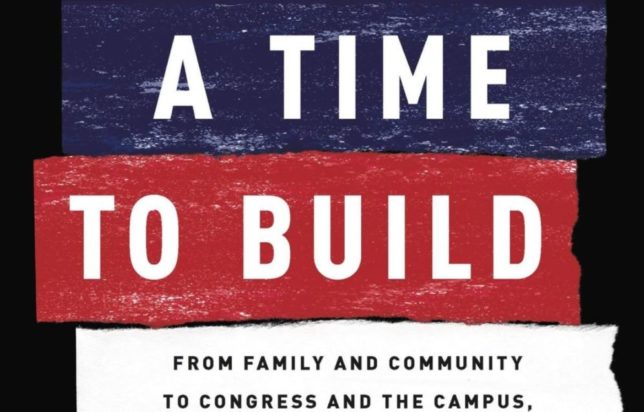Book Profile
Why Should We Build That Which We Cannot Trust?
 "A Time to Build: From Family and Community to Congress and the Campus, How Recommitting to Our Institutions Can Revive the American Dream" by Yuval Levin (2020).
"A Time to Build: From Family and Community to Congress and the Campus, How Recommitting to Our Institutions Can Revive the American Dream" by Yuval Levin (2020).

All organizations that are not actually right-wing will over time become left-wing.
—John O’Sullivan, speechwriter to former British Prime Minister Margaret Thatcher
It may be somewhat odd to debate the thesis of a book published in 2020 in 2021, but the American Enterprise Institute’s Yuval Levin had the misfortune of publishing A Time to Build in March of last year, when the national conversation was somewhat distracted. In his book, Levin, a former official in the George W. Bush administration and de facto dean of right-leaning DC wonks, proposes that Americans recommit to civic and public institutions as a way of fixing the malaise in politics and corralling populist energy.
But if one is politically conservative, Levin’s approach creates a Catch-22: If conservatives recommit to institutions, they are largely committing to institutions that are controlled by managerial progressives and managerial progressive ideology. (Even the military, long seen as conservative, today pays obeisance to critical race theory to “understand white rage.”) O’Sullivan’s Law, quoted above, tells the story of many old and famous institutions built by capitalists and conservatives that have fallen under leftist control, to say nothing of those once nominally independent that have also done so.
So my question to Yuval is this: Given that O’Sullivan’s Law so often prevails, why should conservatives fight for institutions, especially the ones that currently exist? Levin has no answer.
First, the Good
This is not to say that Levin is entirely wrong. He rightly indicts members of Congress for using their offices, which must exist under our system of government, not as constitutional positions to legislate and make deals at least amenable to most of the country, but rather for personal brand building and promotion seeking while ceding real ruling authority to the imperial executive.
Political parties too have been weakened by well-meaning left-progressive reforms in the 1960s and 1970s that moved powers of candidate choice from political actors to primary voters—in practice, to outside spending groups. The McCain-Feingold Campaign Finance Reform Act of the 2000s only made this problem worse. Both facts, as Levin notes, strip parties and offices of their power to “form” incoming legislators (and executives) into the sorts of people who function well in those institutions.
O’Sullivan’s Catch-22
But conservative activists of a certain age will now interrupt, “Hey, wait a minute. I remember when the parties and Congress were formative: They turned good conservatives into [long-time House Minority Leader] Bob Michel’s band of not-so-lovable losers who weren’t able to do very much because they never won majorities.” They are not wrong. Strong institutions have often been very bad for conservative interests because of the structures of the professional class who supply their management and administration.
Choosing one of Levin’s examples, we note he praises the institutional structures of mid-20th century journalism for professionalizing the industry with “a strong ethic and straightforward set of common commitments.” The problem for conservatives is that straightforward set of common commitments was Great Society liberalism (epitomized by CBS newsreader Walter Cronkite), and that ethic was jettisoned each moment it served Democratic political interests. For the most egregious example, see Dan Rather’s 2004-election-eve promotion of falsified documents alleging then-President George W. Bush had gone AWOL from military service. When bloggers and internet activists debunked the prestige media man’s false claims, they created the demand for the disaggregated media to which Levin objects.
Levin wrote A Time to Build when reports of a new, concerning flu-like illness in Wuhan, China, were a curiosity rather than the central fact of human life and government, which probably explains why he bemoans the medical profession having lost “control over privileged knowledge” and suffered “challenges to its expertise.” After 75 weeks of “two weeks to slow the spread” and medical dictatorship, marked by among other abuses the Centers for Disease Control inexplicably reversing its masking guidance for vaccinated Americans, Oregon requiring masks to be worn outdoors contrary to all knowledge about how that illness transmits, and a Biden administration “eviction moratorium” that even the President Joseph Biden admits is likely illegal, it is easy to see that medicine (especially public health), like journalism, has been compromised by the left-progressive ideology of the people who make up the profession. The leaders of the mandatory-muzzle teachers unions predictably cheer all this, while still often opposing mandatory vaccinations of their members.
Those who support the Biden-Weingarten CDC’s decisions have made the subtext the text. Amanda Carpenter, a former Republican political consultant, wrote on Twitter: “Until we have a [vaccine] for 12 and under and enough vaccinated [people] to protect the vulnerable, the responsible folks, including school children, are going to be punished for other people’s mistakes.” Carpenter now runs a nominally Republican group that supports the Democratic agenda, appears as a GOP-defector commentator for CNN, and writes for the Bulwark, a website that was until recently identified as part of a nonprofit network funded by Pierre Omidyar to attack mainstream Republicans. In plain language, a defender of the CDC, the most powerful institution in 2021 America, declares that the purpose of a nominally medical action is to incite hatred of the current administration’s political opposition and punish them.
The Roll of the Hijacked
Institutional left-turns apply far beyond government itself and even organized labor, which has always been left of center if not as far left as it is today. Indeed, the tentacles of the left-progressive administrative class extend even into organizations that started as right-wing.
CRC’s long interest in donor intent is a testament to managerial progressive administrators’ ability to hijack even explicitly right-wing organizations, often with aid and comfort from silver-spoon champagne socialist heirs. Some of the biggest names in Big Liberal Philanthropy—the Ford Foundation, the Pew Charitable Trusts, the MacArthur Foundation—all began as pro-capitalist or right-leaning and now support the institutional Left.
Conclusion
The problem for Levin’s conservative pro-institutionalism is the same as that of Oren Cass’s “labor conservatives” who seek to strengthen organized labor: Why should conservatives strengthen entities that are out to get them? The Federalist’s Inez Stepman put it succinctly: “If you can’t see that our institutions are themselves the chief cause of mistrust, you’re singularly unequipped for the age.”
In his prior book The Fractured Republic, Levin at least offered an approach: “All sides in our culture wars would be wise to focus less attention than they have been on dominating our core cultural institutions, and more on building thriving subcultures.” In short, broad decentralization. However, in the intervening years centralization has if anything increased, putting even more power in the hands of the managerial progressive class that rules Washington, DC; New York City; San Francisco; and Hollywood.
Before Levin and Cass can persuade conservatives to recommit to institutions, they owe themselves and those whom they would persuade an accounting of the difficulty of their proposed task. To effect conservative change—indeed, even to protect the existing conservatives within these institutions—they will need to commit to a multi-decade process of retaking control of the entities to which they would have us defer and by which they would have us ruled. Instead, they are rushing in headlong without a plan except moral suasion. If this is the best intellectual fervent that the Beltway conservative movement has, we should not be surprised that we got the presidency of Donald Trump.



